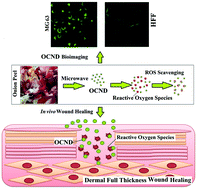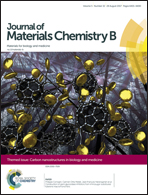Onion derived carbon nanodots for live cell imaging and accelerated skin wound healing
Abstract
Nitrogen, sulfur, and phosphorous co-doped water-soluble carbon nanodots are synthesized from culinary waste onion peel powder (OPP) by a short microwave treatment. Onion Derived Carbon Nano Dots (OCND) that comprised hydrophilic group-decorated amorphous nano-dots exhibited bright, stable fluorescence at an excitation of 450 nm and emission wavelength at 520 nm along with a free radical scavenging property. The OCND exhibited excellent stability at different pH and UV exposure. Although extracted polyphenols degraded in the extract, interestingly it was shown to be cytocompatible and blood compatible as observed during cytotoxicity, fluorescence imaging of the cell and a hemolysis study. The present work not only focuses on the synthesis of OCND from the OPP extract but also provides an interesting fact that, even after the degradation of polyphenols in the extract, they are non-toxic to human cells (HFF & MG63) and RBCs. Moreover, OCND had no adverse effect on the migration rate of Human Foreskin-derived Fibroblasts (HFFs) as observed from a scratch assay. In addition to accelerating the migration rate of fibroblasts, the OCND altered intra- and extracellular reactive oxygen species (ROS) by enhancing the antioxidant mechanism of a fibroblast under oxidative stress. Further, OCND was observed to accelerate wound healing in a full thickness (FT) wound in a rat model for topical application, which can be attributed to its radical scavenging potential. In summary, this study leads to a new type of OCND synthesis route, which is inherently co-doped with phosphorous, sulfur and nitrogen and holds a great promise for a myriad of biological applications, including bio-imaging, free radical scavenging and wound healing.

- This article is part of the themed collection: Carbon Nanostructures in Biology and Medicine


 Please wait while we load your content...
Please wait while we load your content...